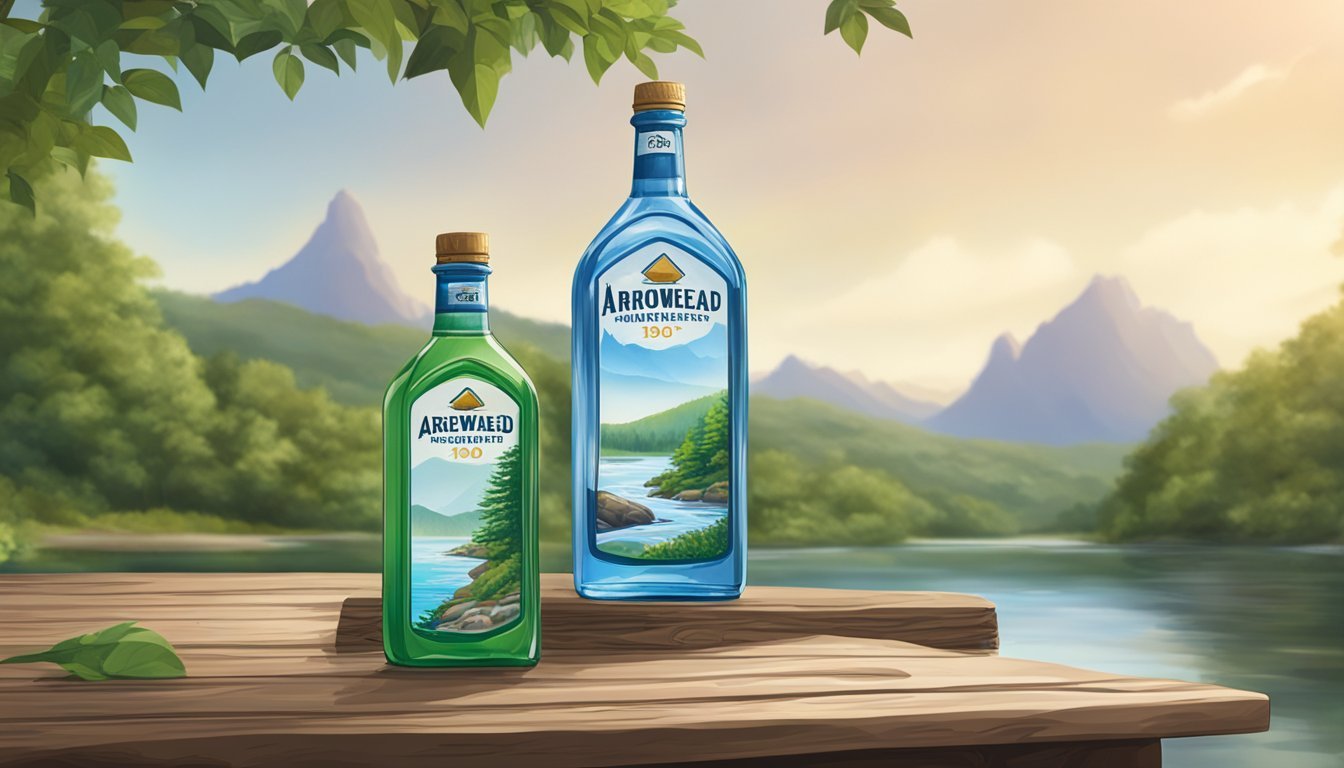Arrowhead vs. 1907water
A Comparative Analysis
When it comes to selecting the best bottled water, Arrowhead and 1907water often come up as strong contenders. Arrowhead, known for its affordability and availability, might attract those prioritizing cost and convenience. On the other hand, 1907water, sourced from New Zealand, appeals to consumers looking for premium quality and distinctive taste.
For those who value taste and origin, 1907water stands out with its smooth and fresh flavor, derived from artesian water sources in New Zealand. In contrast, Arrowhead is derived from various springs in the western United States, offering a more localized option with a slightly mineral taste that some may find appealing or familiar.
Ultimately, the choice between Arrowhead and 1907water hinges on individual preferences. Whether one values the crisp, clean taste of artesian water or the reliability and cost-effectiveness of a widely available brand will determine which stands out as the better option for their needs. Readers will find a detailed comparison of these two brands in terms of taste, sourcing, and value in the following sections.
Understanding Bottled Water: Definitions and Industry Overview
Bottled water has become a staple in households worldwide, serving diverse needs from hydration to convenience. This section covers the types, regulatory standards, and major players in the industry.
Types of Bottled Water
Bottled water can be classified into several types, each defined by its source and purification process. Spring water comes from underground formations and flows naturally to the surface. Purified water has been treated to remove contaminants and is often sourced from public water supplies.
Mineral water contains a specific amount of dissolved minerals from its natural source. Artesian water is from wells tapping confined aquifers. Each type offers unique qualities affecting taste, minerals, and purity.
Regulatory Bodies and Standards
Bottled water standards are overseen by various regulatory bodies to ensure safety and quality. The U.S. Food and Drug Administration (FDA) regulates bottled water similarly to food products, setting limits on contaminants and labeling requirements.
The Environmental Protection Agency (EPA) governs tap water standards, often mirrored in bottled water regulations. Industry groups like the International Bottled Water Association (IBWA) also set supplementary guidelines. These standards ensure that bottled water is safe and meets consumer expectations for purity and quality.
Popular Bottled Water Brands
Several major brands dominate the bottled water market, each bringing unique attributes. Nestlé's Pure Life and Poland Spring are well-known for their wide distribution and spring water sources. Coca-Cola offers Dasani, a purified water brand, while PepsiCo markets Aquafina, also purified.
Brands like Arrowhead are recognized for their mountain spring origins, whereas 1907water emphasizes its naturally alkaline content. Each brand's distinct features cater to varying consumer preferences, from taste to mineral content.
Arrowhead Mountain Spring Water
Arrowhead Mountain Spring Water is known for its sustainability initiatives and a distinct taste profile. By sourcing water from natural springs primarily in the Western United States, it promises a refreshing and crisp experience in environmentally conscious packaging.
Source and Origin
Arrowhead sources its mountain spring water from carefully selected springs in and around the Rocky Mountains. These springs are chosen for their purity and natural mineral content.
The water is sourced from a region renowned for its clean and pristine natural environments. Each spring contributes unique characteristics to the water based on local geology, which results in slight variations in taste and mineral content.
Taste and Mineral Content
The taste of Arrowhead Mountain Spring Water is often described as clean and refreshing, with a hint of natural minerals. This taste profile can vary slightly depending on the specific spring source.
Mineral content in Arrowhead water includes essential elements such as calcium and magnesium, which contribute to its crisp taste. The variation in natural minerals not only impacts taste but also provides minor health benefits.
Environmental Initiatives and Packaging
Arrowhead has made significant strides in sustainability, notably with the introduction of their 100% recyclable aluminum bottles. This move aims to reduce plastic waste and promote recycling.
Additionally, their bottles made from recycled plastic demonstrate a commitment to environmental responsibility. They actively support local communities and work towards reducing their carbon footprint through sustainable bottling practices and materials.
1907water: Unveiling the Brand
1907water is a unique bottled water brand from New Zealand known for its natural qualities, purity, distinct taste, and commitment to environmental sustainability through its innovative bottle design.
Source and Natural Qualities
1907water sources its water from a pristine artesian aquifer in New Zealand.
Artesian water is collected from underground sources, ensuring a natural filtration process.
This spring water is known for its high-quality and mineral-rich composition, contributing to its reputation as a premium product.
The source location adds to the brand's allure, providing a clean and unpolluted origin.
Taste Profile and Purity
1907water boasts a crisp and clean taste, often described as refreshing and smooth.
This results from the natural filtering process through volcanic rock, which adds minerals while maintaining purity.
There are no artificial additives or preservatives, ensuring a natural flavor that appeals to those seeking pure hydration.
Consumers often note the balanced pH level, which enhances the drinking experience.
Environmental Commitment and Bottle Design
1907water demonstrates a strong commitment to environmental sustainability.
The brand recently introduced glass bottles, reducing plastic use and contributing to eco-friendly practices.
These bottles are not only recyclable but also aesthetically pleasing, featuring designs by local New Zealand artists.
This focus on sustainability is part of the brand’s identity, appealing to environmentally conscious consumers looking for more responsible choices.
Comparison of Water Sources
Arrowhead utilizes natural spring water sourced from springs in the San Bernardino Mountains. This groundwater is renowned for its purity and is filtered through layers of volcanic rock, which enhances its mineral content.
1907water is sourced from an artesian aquifer in New Zealand. This groundwater is naturally filtered through volcanic rock, giving it a unique mineral composition and a high pH level.
Water Source Comparison:
Brand Source Type Location Filtration Method Arrowhead Natural Spring San Bernardino Mountains Volcanic Rock 1907water Artesian Aquifer New Zealand Volcanic Rock
Both brands emphasize natural filtration through volcanic rock, resulting in distinct mineral profiles. Arrowhead's source in California contrasts with 1907water's distant source in New Zealand, providing consumers with unique regional characteristics.
Taste and Purity
When comparing Arrowhead and 1907water, two key factors to consider are taste and purity. These elements greatly influence consumer preference and trust in bottled water brands.
Assessing Taste Variations
Arrowhead is known for its crisp, natural taste, which many attribute to its source from natural springs. The water provides a refreshing experience, but some consumers report a slight mineral aftertaste. This can be due to the presence of naturally occurring minerals, which may not appeal to everyone's palate.
1907water, sourced from New Zealand, emphasizes its smooth and clean taste. The water undergoes natural filtration through ancient volcanic rocks, resulting in a slightly alkaline pH of around 7.8 to 8.2. Consumers often praise this smoothness and lack of any aftertaste, which sets it apart from competitors.
Both brands aim to provide a satisfying taste experience. Arrowhead's robust profile contrasts with 1907water's velvety texture, catering to different preferences in water taste.
Purity Concerns and Contaminant Levels
Purity is a critical factor for bottled water. Arrowhead sources its water from springs, which may contain trace amounts of minerals. However, the brand subjects its water to rigorous quality testing to ensure safety. Some reviews mention concerns over heavy metals and contaminants, like PFAS chemicals and lead, which are tested regularly to meet safety standards.
1907water prides itself on its natural purity, with its source being remotely located. This isolation helps minimize contamination risks. The water is tested for contaminants, including arsenic and other harmful substances. Testing reports often show minimal to non-existent levels of these contaminants, making it a trustworthy choice for consumers prioritizing purity.
Both brands adhere to industry standards for purity, but 1907water's reputation for fewer contaminants and its natural filtration process might give it an edge in this category.
Health Implications
When comparing Arrowhead and 1907water, several health factors come into play, including hydration, electrolyte balance, minerals, and pH levels.
Hydration and Electrolyte Balance
Proper hydration is key for overall well-being, and it goes beyond simply drinking water. Both Arrowhead and 1907water aim to keep consumers hydrated, but their electrolyte content differs.
Arrowhead water is sourced from mountain springs and contains some naturally occurring electrolytes like calcium and magnesium. However, it’s essential to check the label for exact levels, as they can vary.
1907water, sourced from New Zealand, also includes natural electrolytes, which can help with rehydration. They specifically highlight the presence of silica, which is noted for its role in connective tissue health.
Electrolyte Summary:
Arrowhead: Natural spring water with variable electrolytes.
1907water: Natural electrolytes, notably silica.
Effects of Minerals and pH Levels
Minerals and pH levels in water impact its health benefits. Arrowhead water has a pH of 6.83, making it slightly acidic. Despite this, it contains beneficial minerals, but concerns about contaminants have been raised. Studies detected chemicals like arsenic, nitrates, and bacteria like E. coli in some samples, which is worrying for long-term health.
1907water boasts a pH of 7.8, making it alkaline. Alkaline water enthusiasts argue that it helps neutralize body acidity. Additionally, 1907water promotes the purity of its water with fewer reports of contaminants, adding to its appeal as a healthier option.
Mineral and pH Highlights:
Arrowhead: pH 6.83, potential contaminants, and useful minerals.
1907water: pH 7.8, alkaline, stable purity level.
Careful consideration of these factors can guide individuals in choosing the bottled water that best supports their health needs.
Environmental Considerations
Examining the environmental impacts of bottled water brands like Arrowhead and 1907water requires looking at both the production and recycling of their plastic bottles and the impact of their water extraction processes on ecosystems.
Bottle Production and Recycling
Plastic bottles account for a significant portion of the environmental footprint of bottled water. Arrowhead and 1907water use PET plastic for their bottles, which is both lightweight and durable.
However, the production process for plastic bottles is resource-intensive, consuming fossil fuels and releasing greenhouse gases.
Recycling rates vary significantly between the two brands. While Arrowhead has made efforts to use recycled plastic in their bottles, the effectiveness of their recycling programs is uneven. The demand for recycled plastic often outpaces supply, hindering widespread adoption.
1907water markets itself as using more environmentally friendly packaging options, including bottles made from a higher percentage of recycled materials. They have emphasized reducing their carbon footprint through better manufacturing practices and increased reliance on post-consumer recycled plastic.
Water Extraction's Impact on Ecosystems
The extraction of water for bottling can have serious repercussions on local ecosystems. Arrowhead sources water from various springs, primarily in California. This region has faced criticism due to its water scarcity issues, and extensive water extraction has raised concerns about depletion of local water resources and negative impacts on regional ecosystems.
1907water, which sources its water from New Zealand, claims to draw from sustainable, naturally replenished sources. Their extraction processes are designed to minimize ecological disruption, preserving the natural balance of the environment.
Both companies must navigate the regulatory landscapes of their respective regions, as well as ongoing scrutiny from environmental watchdogs, to ensure their practices support long-term ecological health.
Packaging and Accessibility
Arrowhead and 1907water offer distinct approaches in packaging, influencing user convenience and environmental impact.
Arrowhead primarily uses plastic bottles for their products. These are lightweight and easy to carry, making them convenient for on-the-go consumption. The plastic used is recyclable, but it still raises concerns about environmental sustainability.
1907water opts for glass bottles. These bottles provide a premium feel and maintain water quality better by avoiding plastic's potential chemical leaching. Glass is fully recyclable, though its weight can be inconvenient for portability.
In addition to glass, 1907water also offers boxed water options. This packaging is eco-friendly and reduces plastic use. Boxed water is easier to stack, store, and transport, adding to its accessibility.
Arrowhead's plastic bottles are commonly found in various convenient store sizes ranging from small 500 ml bottles to larger 1.5-liter bottles. This variety allows consumers to choose according to their needs.
1907water's packaging might be limited by the heavier weight of glass bottles, which can be more cumbersome for everyday use. However, the boxed water provides an alternative that balances sustainability with convenience.
Convenience, in terms of portability and ease of use, tends to favor Arrowhead due to its lightweight plastic bottles and widespread availability. On the other hand, those prioritizing sustainability might lean towards 1907water’s eco-friendly options.
Ultimately, both brands cater to different consumer preferences regarding packaging and accessibility, with Arrowhead prioritizing convenience and 1907water focusing on sustainability.
Consumer Considerations
When comparing Arrowhead and 1907water bottled water brands, several factors are critical, including pricing, brand ethos, market presence, and availability in both physical stores and online. Each of these elements can significantly influence consumer preferences and choices.
Pricing and Value
Arrowhead often positions itself as an affordable choice, making it popular among budget-conscious consumers. The price point allows for accessible hydration without compromising on essential standards. In contrast, 1907water carries a premium price tag, reflecting its artesian origins and commitment to high-quality, eco-friendly packaging.
For consumers, value isn't solely based on cost. Arrowhead provides good value for everyday needs, while 1907water appeals to those seeking a more premium experience.
Brand Ethos and Market Presence
Arrowhead boasts a long-standing reputation, deeply rooted in providing reliable and affordable water. Based in the United States, it is known for sourcing from natural springs, emphasizing sustainability in its practices.
1907water, on the other hand, hails from New Zealand. Its brand ethos focuses heavily on purity and sustainability, leveraging its artesian source to offer naturally alkaline water. The market presence of 1907water is growing, especially amongst health-conscious consumers and those interested in environmentally friendly products.
Availability in Stores and Online
Arrowhead is widely available in numerous grocery stores across the United States. Its extensive distribution network ensures that consumers can easily find it both in physical retail locations and through various online platforms.
1907water, being a premium and niche product, has more limited availability. It is found in certain specialty and health-focused stores and is increasingly present on e-commerce sites. While not as ubiquitous as Arrowhead, its online availability helps bridge the gap, providing consumers with convenient access.
In summary, when evaluating Arrowhead and 1907water, consumers must weigh several considerations, including pricing, brand values, and availability. These factors are crucial in determining which bottled water brand better meets an individual's needs and preferences.
Final Thoughts
When comparing Arrowhead and 1907water, several factors come into play.
Arrowhead is often cited for its wide availability and affordability. Yet, it has faced criticism for taste, with some consumers noting an off-flavor that might be linked to the presence of microplastics.
1907water, sourced from New Zealand, offers a distinctively clean taste. It is also praised for its alkaline properties, which some believe contribute to better hydration. Its sleek packaging adds a premium feel, but it is typically more expensive and harder to find.
Feature Arrowhead 1907water Source Mountain springs New Zealand springs Taste Mixed reviews Highly rated Availability Widely available Limited Price Affordable Premium Packaging Standard Sleek and modern
The choice between Arrowhead and 1907water ultimately depends on what matters most to the consumer: taste, source, availability, or price. While some prefer the dependable and accessible nature of Arrowhead, others might opt for the premium experience offered by 1907water. Each brand has its own strengths, catering to different preferences and priorities in the bottled water market.







